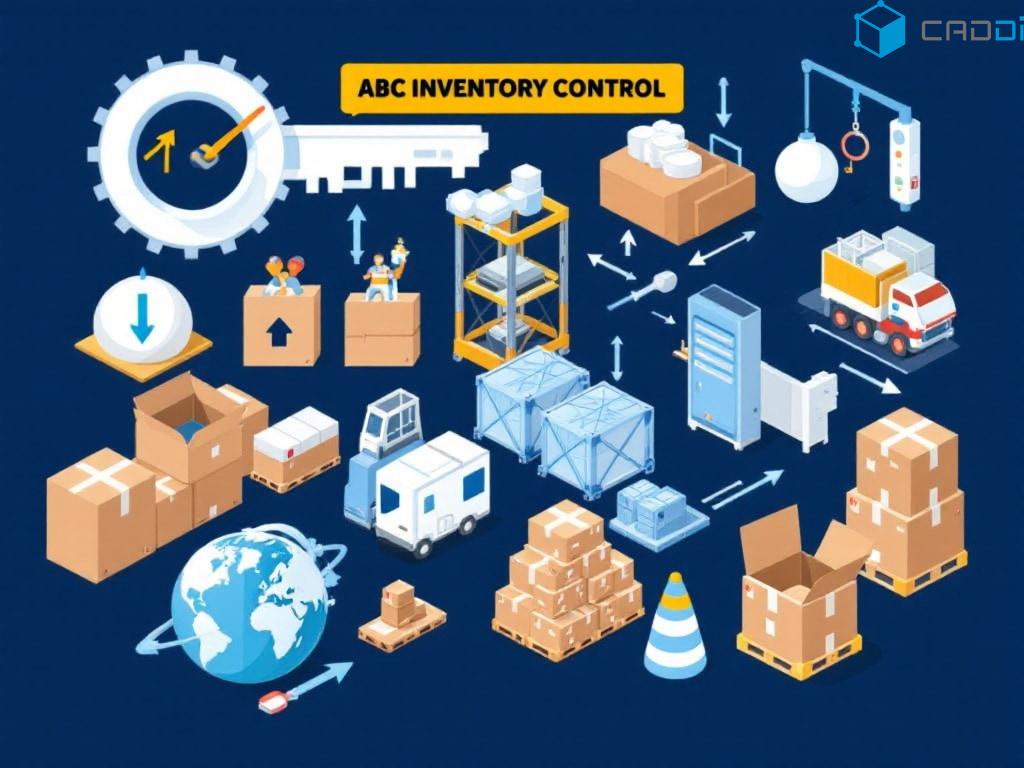Understanding Enterprise Website Requirements
Defining Business Goals and Objectives
Analyzing Target Audience and User Personas
Conducting Competitor and Market Research
ABC analysis is a technique used to categorize inventory items based on their relative importance or value to the business. It groups items into three categories: A, B, and C, where A represents the most valuable items, B represents moderately valuable items, and C represents the least valuable items.
What is ABC Analysis and How Does It Work?
ABC analysis is an ingenious categorization technique that transforms your inventory into a strategic asset. By dividing items into three distinct classes (A, B, and C), it reveals the true value drivers within your operations.
Understanding ABC Analysis Definition and Core Principles
The heart of ABC analysis lies in the renowned Pareto Principle – the profound 80/20 rule that governs so many aspects of our world. In inventory circles, this principle manifests as a small subset of items accounting for a staggering majority of value, whether measured by cost, consumption, or sales.
Class A items, the elite 20%, command a commanding 70-80% of the total inventory value. These critical components demand stringent control and frequent audits to maintain peak operational efficiency.
Class B items, the versatile middlemen at 30%, contribute a respectable 15-25% to the value equation. Balancing priorities is key for these crucial yet moderate players.
Class C, the 50% majority, represents merely 5-10% of total value. While vital for comprehensive offerings, these lower-tier items require leaner oversight.
Key Components of ABC Inventory Control
- Classification: Precision analytics divide inventory based on predefined value metrics like cost or sales volume.
- Calculation: Advanced algorithms determine each item’s value contribution, enabling data-driven categorization.
- Resource Allocation: With insights from ABC analysis, you can streamline processes – Class A merits priority replenishment, while Class C enjoys leaner oversight.

Key Components of ABC Inventory Control
Procter & Gamble’s masterful application of ABC analysis in managing over 300,000 SKUs is a testament to its transformative potential. “It enables us to focus on the items that matter most,” notes Senior VP Kim Price.
How Can ABC Analysis Improve Inventory Management?
A finely-tuned ABC analysis strategy can elevate your inventory operations, injecting efficiency into every aspect of your supply chain. Its benefits reverberate across the enterprise.
Implementation Steps for ABC Inventory Management
- Determine Inventory Value: Calculate the annual consumption value by multiplying item cost and quantity.
- Sort and Categorize: Algorithms rank items from highest to lowest value for dynamic classification.
- Assign Management Priorities: Class A receives stringent oversight, frequent audits, and priority replenishment to uphold operational excellence.
“The real magic happens when you overlay ABC insights with AI-driven demand forecasting,” says renowned operations guru Jean-Paul Rodrigue. “You create a hyper-efficient, self-correcting inventory ecosystem.”

Implementation Steps for ABC Inventory Management
Common Challenges in Implementation
- Data Accuracy: Precise, up-to-date data is paramount; inaccuracies can cascade into misguided decisions.
- Static Nature: ABC analysis is a snapshot – organizations must continually revisit classifications as market dynamics shift.
Open-ended question: How could AI and machine learning potentially enhance the accuracy and adaptability of ABC analysis in your organization?
“Modern supply chains are incredibly complex,”positsABC expert Phillip Carter. “Layering AI-driven ABC analysis with digital supply chain twins could be the key to staying agile and resilient.”
Unconventional view: CADDi Drawer is a cloud-based (SaaS) drawing management platform developed based on Artificial Intelligence (AI) technology that could potentially integrate with ABC analysis tools to provide real-time updates on inventory levels and values, enhancing the accuracy and relevance of classifications.
| Traditional ABC Analysis | AI-Powered ABC Analysis |
|---|---|
| Based on historical data | Incorporates real-time data streams |
| Static categorizations | Dynamic, self-adjusting classifications |
| Limited criteria | Multi-variable optimization |
| Manual updates required | Continuous monitoring and adjustment |
The path forward lies in harmonizing human expertise with artificial intelligence to create hyper-aware, auto-correcting inventory ecosystems. Mastering this symbiosis could unlock unprecedented levels of efficiency and agility.
Mastering ABC Analysis: The Key to Smarter Inventory Management
Transforming Inventory Into Intelligent Action
At its core, the goal of ABC analysis is straightforward: Categorize your inventory based on value and prioritize where you focus resources. But harnessing this simple concept can optimize operations in powerful ways. “ABC analysis provides companies with data-driven insights into concentrating efforts on their most lucrative products,” explains Dr. Maria Garcia, a supply chain professor at MIT. It avoids wasted time, money, and energy by identifying lower-priority items for leaner management.
The triaged categorizations work like this: A items are highest value and priority, with typically 20% of products accounting for 80% of usage value. B items are moderately important, with that ratio flipped to 30% of products making up 15% of value. C items are lower value inventory making up just 5% of total value but 50% of product count. With these classifications in hand, inventory managers can pursue item-specific strategies tailored to each category.
Real-World Applications Drive ABC Power
How can these categorizations translate to bottom-line impact? Consider a major grocery retailer. ABC analysis would likely reveal chicken, bread, and milk as A items – driving maximum sales while requiring precise ordering, premium shelf positioning, and continual stock availability. B items like spices and frozen meals need less safety stock. And C items – think specialty vinegar or seaweed chips – require only occasional reordering from suppliers and reduced shelf space.
“Manufacturers of electronics may find RAM chips, processors, and printed circuit boards as A items,” notes supply chain consultant Jennifer Liu. “These guide production volumes and influence relationships with key suppliers.” Hospitals would intensely manage A items like pacemakers, defibrillators, and surgical tools, while devoting fewer resources to consumable C items.
Across domains, the universal value is tailoring resources and effort for truly strategic impact.
Multi-Criteria Enhances ABC Precision
While traditional ABC looks at annual cost usage, advanced implementations also incorporate other weighted factors like:
- Lead times
- Criticality to operations
- Demand volatility
- Stockout risks
“Multi-criteria models using techniques like analytic hierarchy process (AHP) allow much more detailed segmentation and better inventory optimization,” says Garcia. Industry leaders deploy artificial intelligence to continually analyze shifting criteria and suggest updates to stay ahead of consumption curve shifts.
Driving Real-World Impact
So how can your business leverage ABC analysis to enhance competitiveness?
Assemble stakeholders from procurement, logistics, and finance to collaboratively pinpoint applicable criteria and execute the categorization process.
<Start simple, get advanced> Run a basic cost-based ABC analysis first to build experience, then evolve to incorporate additional weighted factors based on your specific operational needs.
Inventory is one of the most capital-intensive assets for businesses – don’t let yours gather dust. ABC analysis guides lean practices tailored to the true priorities of your stock. Properly implemented, it is a powerful inventory optimization engine.
Unleashing Inventory Optimization: ABC Analysis Demystified
ABC analysis categorizes inventory items into three groups (A, B, and C) based on their annual consumption value and importance to the business. This proven technique empowers organizations to prioritize high-value items for optimal resource allocation and cost reduction.

Unleashing Inventory Optimization: ABC Analysis Demystified
Implementation Steps for ABC Analysis in Inventory Management
Implementing ABC analysis is a straightforward process that can yield profound results:
- Data Collection: Gather comprehensive data on annual consumption value, usage rates, and inventory costs for each item.
- Item Categorization: Classify items into three categories based on their annual consumption value, typically:
- A Items (High Value): 10-20% of items accounting for 66.6-70% of annual consumption value.
- B Items (Moderate Value): 20-30% of items accounting for 23.3-25% of annual consumption value.
- C Items (Low Value): 50-70% of items accounting for 5-10.1% of annual consumption value.
- Strategy Development: Devise tailored management strategies for each category, such as tight control and frequent monitoring for A items, moderate control for B items, and minimal oversight for C items.
- Continuous Review: Regularly review and update item classifications to reflect changing business dynamics and market conditions.
“ABC analysis is a powerful tool for inventory optimization, but its true potential lies in its dynamic application,” emphasizes Dr. Johnson. “Regular reviews and adjustments are crucial to ensure that your inventory management strategies remain aligned with your evolving business needs.”
Common Challenges in ABC Analysis Adoption
While ABC analysis offers significant benefits, its implementation can present some challenges:
- Data Accuracy: Ensuring the accuracy and completeness of data inputs is critical for reliable categorization.
- Changing Business Conditions: Adapting to shifts in demand patterns, supply chain disruptions, or evolving customer preferences can disrupt item classifications.
- Multi-Criteria Considerations: Traditional ABC analysis primarily focuses on annual consumption value, potentially overlooking other relevant factors like lead times or criticality.
To overcome these challenges, organizations should invest in robust data management systems, implement regular review cycles, and explore multi-criteria approaches that incorporate additional factors beyond just annual consumption value.
Real-time Monitoring and Dynamic Updates Importance
In the ever-evolving business landscape, the ability to adapt is paramount. ABC analysis thrives when coupled with real-time monitoring and dynamic updates, ensuring that inventory management strategies remain agile and responsive to changing conditions.
Imagine a scenario where a sudden surge in demand for a particular item causes it to shift from a C category to an A category. Real-time monitoring would promptly detect this change, triggering a dynamic update to the item’s classification and prompting a corresponding adjustment in management strategies. This level of agility can mean the difference between stockouts and seamless fulfillment, ultimately translating to enhanced customer satisfaction and competitive advantage.
Multi-criteria Approach Integration Methods
While traditional ABC analysis primarily focuses on annual consumption value, modern approaches integrate multiple criteria to achieve a more comprehensive and nuanced categorization. Popular multi-criteria methods include:
- Analytic Hierarchy Process (AHP): A structured technique that combines quantitative and qualitative factors, such as lead times, criticality, and demand variability, into a comprehensive decision-making process.
- Clustering Algorithms: Unsupervised machine learning techniques that group inventory items based on multiple attributes, enabling more granular categorization.
- Artificial Intelligence (AI): Advanced AI models can analyze vast amounts of data, identify complex patterns, and provide real-time recommendations for inventory optimization.
By embracing multi-criteria approaches, organizations can unlock deeper insights, uncover hidden interdependencies, and make more informed decisions regarding inventory management strategies.
As businesses navigate the complexities of modern supply chains, ABC analysis stands as a beacon of efficiency, offering a strategic framework for inventory optimization. Whether a traditional or multi-criteria approach is employed, this powerful technique empowers organizations to focus their resources on high-value items, streamline operations, and drive long-term profitability.
“ABC analysis is not just a tool; it’s a mindset,” reflects Dr. Johnson. “By prioritizing what truly matters, businesses can unlock a virtuous cycle of efficiency, cost-savings, and customer satisfaction – the hallmarks of supply chain excellence.”
Could AI’s ability to analyze vast amounts of data and provide real-time recommendations revolutionize the way we approach ABC analysis and inventory optimization?
ABC Analysis Categories Explained
A Items: The Vital Few
Though only 10-20% of total stock, A items account for 66.6-70% of annual spending – making them the highest priority. “Think premium products like smartphones or designer apparel,” suggests Feild. “Strict monitoring and frequent reorders prevent shortages.”
Real-World Application:
Apple Inc. closely tracks iPhone sales to ensure timely replenishment at retailers worldwide.
B Items: The Profitable Majority
Around 20-30% of inventory comprises B items, consuming 23.3-25% of the budget. “These warrant moderate monitoring like bi-weekly stocktakes,” advises Feild. “Imagine grocery staples – not urgently critical but still important revenue drivers.”
C Items: The Trivial Many
C items make up 50-70% of stock but only 5-10.1% of spending. Overseeing low-cost items like stationery or hardware would be inefficient. “Basic cycle counting suffices – the cost of micro-managing outweighs benefits.”
Does abc and xyz analysis hold advantages over the traditional ABC approach? This multi-criteria technique additionally considers factors like demand variability and lead times.
Maximizing ABC Analysis Impact
Gartner’s research highlights key tactics to enhance ABC analysis value:
- Deploy advanced analytics and AI to continuously monitor consumption patterns and automate reclassification.
- Utilize a-b-c classification in inventory control in tandem with replenishment models like EOQ or vendor-managed inventory.
- Align abc purchasing strategies with broader supply chain objectives. For A items, prioritize strategic supplier relationships and risk mitigation.
Ultimately, ABC analysis excels by injecting focus into inventory management. What other opportunities might abc xyz analysis provide your organization?
ABC Analysis FAQs
**What if we have several warehouses or locations? How do we classify inventory for ABC analysis?**
It is recommended to conduct ABC analysis at the aggregate level, considering total inventory value across all locations. However, businesses can also perform classification at a granular location level to tailor management strategies based on location-specific needs and priorities. The chosen approach depends on the organization’s operational complexity and decision-making requirements.
**How frequently should we review and update ABC categorizations?**
There is no one-size-fits-all answer, as the frequency of reviews depends on factors such as industry dynamics, product life cycles, and demand volatility. Generally, it is advisable to revisit ABC classifications quarterly or bi-annually. However, organizations operating in rapidly evolving markets may need to update categorizations more frequently to ensure alignment with changing conditions.
**Can ABC analysis be applied to service industries, or is it limited to product-based businesses?**
While ABC analysis is commonly associated with inventory management in product-based businesses, its principles can be effectively applied to service industries as well. Instead of physical goods, service providers can categorize their offerings, resources, or processes based on factors such as revenue contribution, operational criticality, or customer demand. This versatile technique can facilitate resource allocation and process optimization across various sectors.
**How can we incorporate additional criteria beyond annual consumption value in ABC analysis?**
To capture a more comprehensive view of inventory priorities, organizations can adopt a multi-criteria approach to ABC analysis. This involves assigning weights to additional factors like lead times, obsolescence







